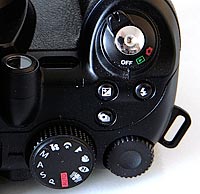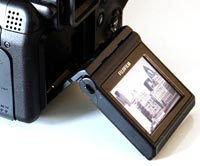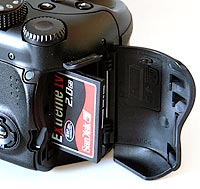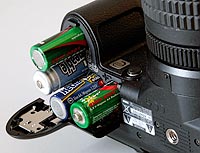Fujifilm Finepix S9600 Review
(also called the Fujifilm Finepix S9100)
Review Date: March 12th 2007
Leave a comment about this Review
|
Introduction

The Fujifilm Finepix S9600 is an upgrade of the S9500 model that was first introduced back in 2005, a long time ago in the ever-changing world of digital cameras. The new S9600 is still being heavily promoted as a better alternative to a digital SLR camera by Fujifilm, and it's not hard to see why by looking at the headline specifications. A 9 megapixel sensor, 28-300mm lens, RAW mode and full manual control are features in common with entry-level DSLRs that cost a lot more than the Fujifilm S9600. The Fujifilm Finepix S9600 also has a lot of other DSLR-like features - completely manual zoom control and focusing ring on the lens, flash hotshoe, viewfinder and an ISO range of 80-1600. Fujifilm have really pulled out all the stops to make the S9600 as similar to a digital SLR as possible. But they haven't stopped there - this camera also offers features that are unique to compact digital cameras and which, the company hopes, will persuade buyers to choose the S9600. There's a new 2 inch inch tilting LCD screen with an improved resolution of 235,000 pixels, integrated lens which avoids problems with dust getting onto the camera's sensor, and a 30fps, 640x480 movie mode. So does the Fujifilm Finepix S9600 have what it takes to really be a viable alternative to the digital SLR? Carry on reading to find out.
Compare Prices
Support PhotographyBLOG: Buy the Fujifilm FinePix S9600 from one of our affiliate retailers:Ease of Use
If you lined up the Fujifilm Finepix S9600 alongside DSLR cameras like the Nikon D40, Canon Digital EOS 400D and Sony Alpha A100, you would be hard pushed to spot the odd camera out at a first glance. All is revealed only when you look at the back of the Fujifilm S9600 when it is turned on, and see the LCD screen showing a live preview of the scene (although some DSLR cameras now do this too), or if you hold the camera up to your eye and look through the electronic viewfinder. The Fujifilm Finepix S9600 has similar dimensions and weight to a DSLR, as well as a chunky hand-grip on the right of the camera that makes it possible to hold with just one hand if you so desire. Unfortunately the Fujifilm Finepix S9600 isn't quite as well built overall as most DSLRs. Its all-plastic body has a bit of flex and creak, although it is well above average for the super-zoom bracket of compact digital cameras. Fujifilm must be congratulated, however, for almost matching the build quality of a DSLR whilst also squeezing in all the other features into the budget.
The other obvious area where the Fujifilm Finepix S9600 follows the design of a DSLR is the lens. Although this is obviously an integrated, non-removable lens, just like on every other compact digicam, Fujifilm have added a mechanical zooming ring on the lens barrel. After using the various zoom button designs on countless compact digicams, being able to use a "proper" zooming mechanism that works in the same way as on a 35mm SLR lens is a breath of fresh air. I find it much more intuitive, quicker and more precise to use than zoom buttons, and for me personally this would be a big attraction of the Fujifilm Finepix S9600 if I were looking to buy a compact digital camera. Fujfilm haven't stopped there, though, as they have also included a manual focusing ring, which allows for very precise adjustments when you want to manually fine-tune the focus. Again, much, much better than the convoluted systems that the majority of compact digital cameras offer. One small point though - it's a shame that the manual focusing ring doesn't automatically over-ride the auto-focusing system. Instead, you have to turn the Focusing dial to Manual before the manual focusing ring becomes operational.
The lens is also inadvertently one of the weaknesses of the Fujifilm Finepix S9600. Optically it's very good, with little distortion given the massive focal range that is on offer, and it also covers most of the shooting situations that you will encounter. Disappointingly, though, Fujifilm still haven't added an optical image stabilisation system to this camera. There is a Picture Stabilisation scene mode which attempts to combat camera shake, but it's no substitute for a true mechanical system. This results in a quite a lot of blurred images at the 300mm telephoto end of the zoom lens, more so than I would have seen on a similar camera with anti-shake. Also, following recent announcements of new models with 15x and even 18x zoom lenses with built-in optical image stabilisation from Sony and Olympus, the Fujifilm Finepix S9600 doesn't compare very well in this department.
 |
 |
| Main Controls | Tilting LCD Screen |
There are quite a lot number of external controls and buttons on the Fujifilm Finepix S9600 (around 20 in total), reflecting the fact that this is a complicated camera in the mould of a DSLR. Most of them are thankfully clearly labeled and common to most cameras. There's a traditional dial on the top of the camera that lets you select the different exposure modes; Program, Shutter Priority, Aperture Priority and Manual. This dial is a typical feature of SLR cameras, and enables you to quickly change between the various modes. The various Scene modes and the Movie mode are also accessed via this dial. As with most other Fujfilm digital cameras, the Fujifilm FinePix S9600 has a Menu button on the rear of the camera which, as you would expect, gives you access to the software menu system. This lets you set various parameters including auto-focus mode, sharpness, white balance and so on.
There is also a small silver button with an F on it, which opens what Fujifilm call the Photo Mode menu. This allows you to control the file quality setting, ISO speed and colour settings (B&W, Chrome or Standard). I'm not really sure why these 3 settings alone should fall under the heading of Photo Mode, and things like white balance and sharpening are just part of the standard menu. And I'm undecided about whether it is a good idea or not. The F button does give quick access to certain features, but you do have to memorise what another button does.
If you have never used a digital camera before, or you're upgrading from a more basic model, reading the comprehensive and easy-to-follow manual before you start is a must. Thankfully Fujifilm have chosen to supply it in printed format, rather than as a PDF on a CD, so you can also carry it with you.
The major dislike that I had with the Fujifilm Finepix S9600 is the EVF display, which works very well on its own terms - the EVF is one of the best that I've looked through and is a pleasure to use - but I still much prefer a traditional, good quality optical viewfinder. As this camera has been designed to replicate a DSLR and has such a long zoom lens, you will invariably compose your images by holding the camera up to your eye. I found that the EVF, excellent though it is, doesn't keep up with the eye quite as quickly or precisely as an optical viewfinder, and it also gave me eye-strain after extended periods of use. On the plus side, there is a lot more visual feedback via the EVF than on most optical viewfinders, it offers 100% scene coverage and you can also playback your images on it!
The LCD screen is the alternative way of framing your shots, and thankfully Fujifilm have upgraded the rather poor version found on the S9500. The Fujifilm Finepix S9600 offers a 2 inch LCD with 235,000 pixels and 100% scene coverage. It's still a little small in today's market, but much more exciting is the fact that it's still mounted on a tiltable axis on the back of the camera (as with the S9500). This makes the S9600 great for street photography, as you can use the screen like a waist-level viewfinder, and also suitable for overhead shots (at a concert, for example). The screen doesn't twist from left to right, though, which would have made it even better. Still, the tilting design does obviously offer a new way of shooting when compared with a DSLR, which must always be held up to eye-level.
 |
 |
| Memory Card Slot | Battery Compartment |
The main menu system on the Fujifilm Finepix S9600 is straight-forward to use and is accessed by pressing the Menu/OK button in the middle of the navigation pad. Quite a lot of the camera's main settings, such as image quality, exposure compensation and ISO speed, are accessed elsewhere, so the main menu system isn't actually that complicated. A vertical row of two tabbed pages along the left sided of the LCD screen represents the sub-menus, with 6 options in each one. At the bottom of the first tab is the Setup option - select this to access 4 more tabbed pages with 21 options in total. The Setup menu contains options that you will probably set once and then forget about. If you are interested in using the camera's RAW format, note that the CCD-RAW option is on page 2, a strange location that almost seems to discourage you from using it. I would have liked to see it alongside the other image quality options in the Photo Mode menu. Due to the average sized LCD screen, the various options and icons are a little on the small side.
The start-up time from turning the Fujifilm Finepix S9600 on to being ready to take a photo is very quick at around 1/2 second, and obviously zooming from the widest focal length to the longest is as quick as you like thanks to the mechanical zooming ring. Focusing is very quick in good light and the camera happily achieves focus most of the time indoors or in low-light situations, helped by an extremely bright and powerful focus-assist lamp. Note that the camera does struggle to lock onto the subject sometimes at the tele-photo end of the lens. The visibility, resolution and refresh rate of the 2 inch LCD screen are very good. It takes about 1 second to store a JPEG image, allowing you to keep shooting as they are being recorded onto the memory card - there is no LCD blackout between each image. RAW mode is a completely different kettle of fish. The Fujifilm Finepix S9600 takes around 5 seconds to store a RAW image, during which you can't take another shot. A definite improvement on the older S9500 camera, but not exactly on a par with a digital SLR. In the fastest Continuous mode the camera takes 1.5 frames per second for up to 4 seconds at the highest JPEG image quality, which is above average for this class of camera given the large 9 megapixel images. All in all the Fujifilm Finepix S9600 is fast in terms of operational speed, especially if you don't use the RAW mode.
Once you have captured a photo, the Fujifilm Finepix S9600 has a good range of options when it comes to playing, reviewing and managing your images. You can scroll through the images that you have taken, view thumbnails, zoom in and out, view slideshows with lots of different settings, delete, protect, trim and rotate an image. You can also add a sound clip to an image, set the print order and the transfer order. The Info button toggles detailed settings information about each picture on and off, such as the ISO rating and white balance, there is a small histogram available and a thumbnail with flashing areas which indicate where the image is over-exposed. When taking a photo, pressing the Info button toggles between the detailed information and the histogram.
In summary the Fujifilm Finepix S9600 is an incremental upgrade of the S9500 that almost combines the features of a true digital SLR with all the advantages of a compact digicam. A few flaws, notably the slow RAW format and puzzling lack of optical image stabilisation, prevent it from being a complete success.
|
![]() PhotographyBLOG
is a member of the DIWA
organisation. Our test results for the Fujifilm Finepix S9600 have
been submitted to DIWA
for comparison with test results for different samples of
the same camera model supplied by other DIWA
member sites.
PhotographyBLOG
is a member of the DIWA
organisation. Our test results for the Fujifilm Finepix S9600 have
been submitted to DIWA
for comparison with test results for different samples of
the same camera model supplied by other DIWA
member sites.
